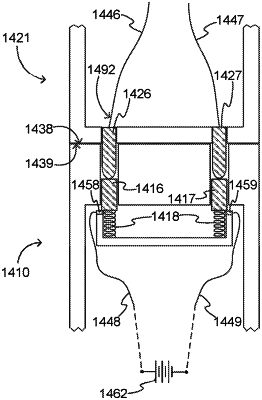| CPC A61H 31/006 (2013.01) [A61H 2201/123 (2013.01); A61H 2201/1207 (2013.01); A61H 2205/084 (2013.01)] | 13 Claims |

|
1. A Cardio-Pulmonary Resuscitation (CPR) system that is usable by a rescuer to care for a patient, the CPR system comprising:
a retention structure including a central member, a leg, and a back plate, the central member configured to couple to the back plate via the leg, the retention structure further including an instrument locking component associated with a well of the retention structure;
a battery wire including a first end, a second end opposite the first end;
a battery configured to be supported by the retention structure and to electrically couple to the second end of the battery wire when the central member is coupled to the back plate, the battery further including an accessory locking component, in which inserting the battery into the well to a threshold distance permits the instrument locking component and the accessory locking component to engage with each other to prevent the inserted battery housing from sliding out of the well when a force is applied to the battery housing against the retention structure;
a motor attached to the central member, the motor configured to electrically couple to the first end of the battery wire and to receive energy from the battery via the battery wire when the central member is coupled to the back plate; and
a compression mechanism attached to the central member and configured to be driven by the motor while the motor receives energy from the battery,
wherein the leg includes a leg electrical contact that physically contacts and is electrically coupled to the second end of the battery wire,
the back plate includes a back plate electrical contact,
the battery is configured to be supported by the back plate and to electrically couple to the back plate electrical contact when supported, and
the back plate electrical contact is configured to physically touch and electrically couple with the leg electrical contact when the back plate electrical contact is electrically coupled to the central member.
|